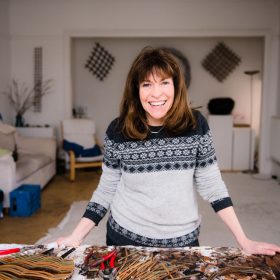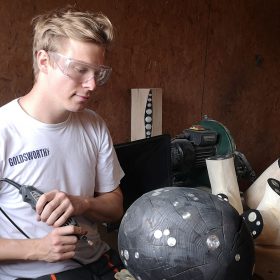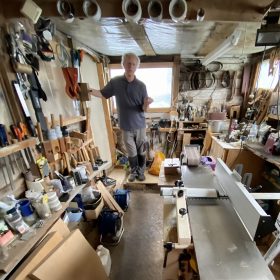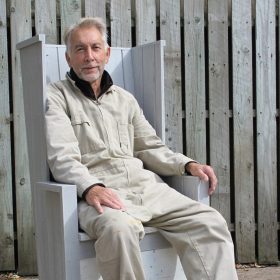Tim Stead’s Four Poster Bed, 1995
This extravagant, fantastical essay in burr elm, is the last in a series of five beds made by Stead between 1975 and 1995. In true Stead fashion, the form links the deep past with a kind of indeterminate future – what the filmmaker Murray Grigor with characteristic, elegant wit termed ‘Pre-Hellenic Post Modernism’.
The bed was made at a time when there was a surfeit of cheaply available elm, the silver lining in the cloud we know as Dutch elm disease. Stead was one of the first artist-woodworkers to unlock the mysterious inner structures and patterns of burr elm and the bed, by definition on a large scale, allowed imagination and material to collide, giving Stead the intellectual and physical space to explore the vast, unknown hinterland the wood offered.
As another astute Stead commentator, Andrew Guest, noted the artist was obsessed by atavistic thoughts, so what better place to lay these bare in the place most of us begin and end our lives, where we procreate and seek solace and comfort?
At the ‘Scotland Creates’ exhibition in Glasgow, in 1990, Stead exhibited a reinterpretation in wood of one of the dwellings at Skara Brae, Orkney’s Neolithic village that lay buried for thousands of years until uncovered by a storm in the winter of 1850.
This bed continues Stead’s pre-occupation with the deep past. Its corbelled roof is an echo of the technique favoured by the builders of stone structures such as Maes Howe, the burial chamber illuminated by the Sun’s rays for a few minutes on the winter solstice. In the bed, lying on one’s back, looking upwards, it’s possible to stare back into the abyss of time and to be moved by the same energies that inspired the neolithic builders of Orkney. In this curtained bed, as in Maeshowe, in the words of Orcadian poet, George Mackay Brown, … The blackness is as solid as a / stone that locks a tomb. / No star shines here…
Here we may sleep and dream, as secure as in the womb, temporarily untroubled and untouched by the colder outside world. Dr Giles Sutherland
The Tim Stead Trust
The Tim Stead Trust was set up to save and preserve ‘The Steading’ in The Scottish Borders, of the eminent sculptor and artist Tim Stead (1952– 2000). Established in 2015, The Trust looks after The Steading and the Tim Stead Archive, to safeguard its future for the nation as an influential and internationally significant example of Scottish craftsmanship and environmental philosophy, all for the benefit of local, national and international communities.
Tim Stead, MBE, was a sculptor, wood artist, furniture designer and maker, photographer, poet, environmentalist, and out-of-the-box thinker. He died in 2000 aged 48. In his all-too-short life, he made furniture for galleries, castles, cathedrals and even for Pope John Paul II for his visit to the UK, yet it was the intuitive, untutored response of ordinary people that most excited Tim. People delighted in his work’s warm honesty and they wanted to live with it. Amongst his most well-loved public works are the interior of Café Gandolfi in Glasgow, the Millennium Clock in Edinburgh and the Oil Industry Memorial Chapel in Aberdeen. Born in Helsby, Cheshire, the youngest of four brothers, Stead was a natural anarchist and a sociable loner. Though rebellious at boarding school, The Leys in Cambridge, he achieved first-class honours in fine art at Trent Polytechnic through a clarity of vision and a passionate dedication to unfashionably palpable, narrative work. There Stead discovered wood with the unstinting support of technician Frank Lindlay. In 1975, Stead did postgraduate work at the School of Art in Glasgow, where he met his life partner, Maggy Lenert, a student from Luxembourg, the day before she was about to leave Scotland.
The Trust wants to use the unique asset of The Steading and its collections as the hub for a Centre for Wood Culture that will build on Tim’s vision and offer the real potential for a sustainable future to support the buildings, the collection, and community-facing activities in the longer-term. The aims of the Tim Stead Trust are to make The Steading and its contents, including the archive works of Tim Stead, accessible to the public and researchers. To provide educational activities that will interpret Tim Stead’s furniture, sculpture, philosophy and poetry. To provide an environment that will encourage wood working skills and enable other artists to flourish. And, to organize workshops that encourage environmental awareness and the artistic use of wood in all its guises.













